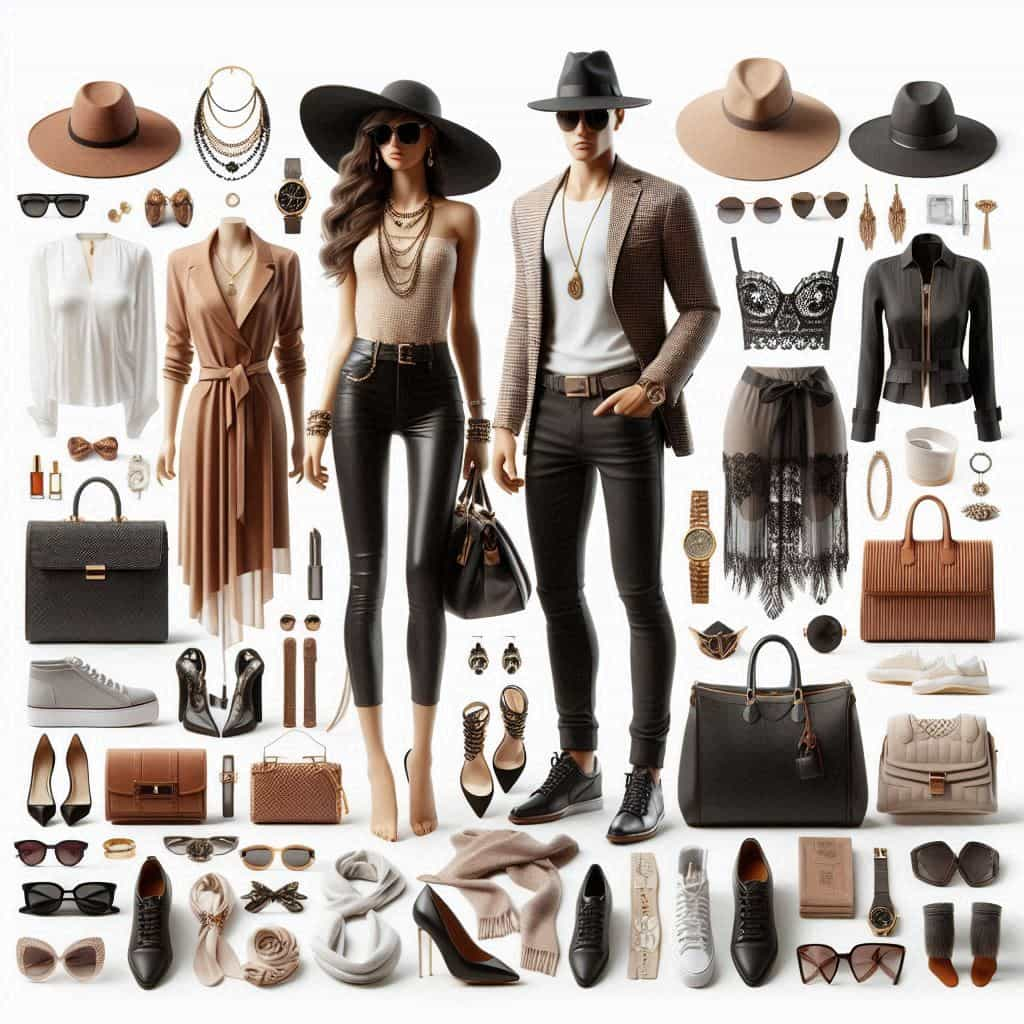
Organizing your wardrobe and planning outfits efficiently can transform how you dress and feel every day. Whether you’re a busy professional or someone who simply wants to look their best with minimal effort, mastering these techniques can save you time and stress. Here’s your comprehensive guide to categorizing clothes, layering for all seasons, mixing styles, and more.
Categorizing Clothes for Easy Outfit Planning
1. Divide Your Wardrobe into Categories
A well-organized wardrobe starts with proper categorization. Here’s how to do it:
- Daily Essentials: Group your everyday wear, like jeans, t-shirts, and casual shirts.
- Workwear: Keep dress shirts, trousers, and blazers in a separate section for easy access.
- Formal Attire: Store suits, dress shoes, and accessories like ties and cufflinks together.
- Seasonal Items: Organize winter coats, summer shorts, and other seasonal wear by season.
2. Use Clear Storage Solutions
To maintain organization:
- Label Containers: Use labels on storage bins or shelves to easily find what you need.
- Hanging vs. Folding: Hang items like blazers and trousers to prevent wrinkles, and fold items like sweaters and jeans.
Layering Clothes: Techniques for All Seasons
1. Layering for Warm Weather
Layering isn’t just for winter. Here’s how to stay stylish and cool:
- Lightweight Fabrics: Use thin, breathable fabrics like cotton or linen.
- Layer Strategically: Wear a light jacket over a shirt or a vest over a t-shirt for added style without overheating.
2. Layering for Cold Weather
Stay warm without sacrificing style:
- Start with Basics: Wear a thermal or long-sleeve shirt as your base layer.
- Add Insulating Layers: Use sweaters or fleece for warmth.
- Finish with a Coat: Choose a stylish coat that complements your outfit and keeps you warm.
Mixing Casual and Formal Elements for Unique Outfits
1. Combine Casual with Formal
Create a balanced look by blending casual and formal elements:
- Casual Blazers: Pair a blazer with jeans for a smart casual look.
- Dress Shirts with Jeans: Wear a crisp dress shirt with dark jeans and loafers for a refined casual style.
2. Add Accessories
Accessories can bridge the gap between casual and formal:
- Smart Shoes: Opt for leather sneakers or loafers instead of traditional dress shoes.
- Stylish Belts: A sleek belt can add a touch of sophistication to casual outfits.
How to Coordinate Your Wardrobe for Effortless Style
1. Build a Cohesive Color Palette
A cohesive color scheme simplifies outfit planning:
- Neutral Colors: Start with neutrals like black, gray, and beige. They’re versatile and easy to mix.
- Accent Colors: Add a few accent colors to liven up your wardrobe without overwhelming it.
2. Choose Versatile Pieces
Invest in clothing that can be dressed up or down:
- Tailored Basics: Opt for well-fitting basics that can be layered or styled differently.
- Multipurpose Items: Choose items like a classic blazer that works for both casual and formal occasions.
Efficient Dressing Tips for the Modern Man
1. Plan Ahead
Save time by planning your outfits:
- Weekly Prep: Plan your outfits for the week on Sunday. This will streamline your mornings.
- Daily Choices: Lay out your clothes the night before to avoid rushing.
2. Create a Go-To Outfit Collection
Have a few reliable outfit combinations ready:
- Work Uniform: Keep a few polished work outfits ready for those busy days.
- Casual Favorites: Have a set of casual outfits that are both comfortable and stylish.
Minimalist Jewelry: Essential Pieces for Every Day
1. Classic Watch
A minimalist watch is a staple accessory:
- Simple Design: Choose a watch with a clean face and minimal detailing.
- Versatile Band: Opt for a neutral-colored band to match various outfits.
2. Basic Rings and Bracelets
Subtle jewelry can enhance your look:
- Simple Rings: A basic metal ring can add a touch of elegance without being overpowering.
- Sleek Bracelets: Choose simple bracelets that complement your watch and outfit.
Using Statement Pieces to Enhance Your Wardrobe
1. Select One Statement Piece
One bold piece can elevate your outfit:
- Statement Shoes or Bags: Choose bold shoes or a distinctive bag to stand out.
- Unique Accessories: Consider a statement necklace or watch to make a strong impression.
2. Balance the Look
Avoid overwhelming your outfit with too many statement pieces:
- Subtle Outfits: Keep the rest of your outfit simple to let the statement piece shine.
- Neutral Base: Wear a neutral base to highlight your statement accessory.
How to Build a Personal Style that Reflects You
1. Experiment and Discover
Finding your personal style involves exploration:
- Try Different Trends: Experiment with various styles to see what suits you best.
- Observe and Adapt: Pay attention to what makes you feel confident and comfortable.
2. Refine Your Style
Once you find what works:
- Invest in Signature Pieces: Add items to your wardrobe that reflect your unique style.
- Create a Style Guide: Develop a personal style guide to streamline your choices and maintain consistency.
The Basics of Men’s Fashion: A Beginner’s Guide
1. Build a Solid Foundation
Start with the essentials:
- Fit Matters: Ensure all clothing fits well. Ill-fitting clothes can ruin a good look.
- Neutral Essentials: Include neutral pieces like a white shirt, dark jeans, and a tailored blazer.
2. Add Variety
Introduce variety to keep your wardrobe interesting:
- Patterned Shirts: Add a few patterned shirts to mix things up.
- Stylish Accessories: Incorporate belts, watches, and other accessories to enhance your outfits.
Quick and Easy Outfit Ideas for Any Occasion
1. Casual Day Out
For a relaxed day:
- Jeans and a T-Shirt: Classic and comfortable.
- Sneakers or Loafers: Choose comfortable footwear that complements your outfit.
2. Smart Casual Gathering
For a semi-formal event:
- Blazer with Jeans: Combine a blazer with dark jeans for a polished yet casual look.
- Dress Shoes or Loafers: Opt for stylish yet comfortable shoes.
How to Create a Capsule Wardrobe That Works for You
1. Focus on Versatility
Choose versatile items that work well together:
- Neutral Pieces: Start with neutral basics like a white shirt, black trousers, and gray sweaters.
- Layering Options: Include layering pieces like jackets and cardigans.
2. Limit and Rotate
Keep your wardrobe simple:
- Seasonal Adjustments: Rotate items based on the season to keep your wardrobe relevant.
- Quality Over Quantity: Invest in high-quality pieces that can be worn in multiple ways.
The Essentials of a Casual Wardrobe for Men
1. Comfortable Basics
Casual wear should be comfortable and practical:
- Jeans and Chinos: Essential for casual days.
- Casual Shirts and Polos: Great for everyday wear.
2. Casual Footwear
Choose comfortable yet stylish shoes:
- Sneakers: Versatile and great for most casual outfits.
- Loafers or Casual Boots: Add variety to your footwear collection.
How to Achieve the Perfect Smart Casual Look
1. Combine Casual and Formal
Mix casual and formal elements:
- Blazer Over a T-Shirt: Elevate a t-shirt with a blazer.
- Tailored Trousers: Pair with a casual shirt for a polished look.
2. Accessorize Smartly
Use accessories to enhance the smart casual look:
- Stylish Belts: Opt for a sleek belt to add sophistication.
- Clean Shoes: Choose loafers or dress shoes that are clean and well-maintained.
Defining Your Signature Look: Tips and Tricks
1. Identify What Works
Discover your unique style:
- Experiment: Try different styles to see what resonates with you.
- Consistency: Once you find your style, build a wardrobe that reflects it.
2. Build Around Signature Pieces
Invest in items that define your style:
- Signature Pieces: Include items that showcase your personal taste.
- Tailored Fit: Ensure that all your clothes fit well and complement your signature pieces.
Dressing Up and Down: Understanding Fashion Formality
1. Casual to Formal
Learn how to transition between casual and formal wear:
- Casual Base: Start with casual wear and add formal elements like a blazer or dress shoes.
- Formal Adjustments: To dress down, swap out formal pieces for casual ones while maintaining a polished look.
2. Smart Casual Middle Ground
Smart casual is the perfect balance:
- Mix and Match: Combine casual items like jeans with formal elements like a blazer.
- Comfort and Style: Maintain comfort while looking sophisticated.
By organizing your wardrobe, experimenting with styles, and understanding fashion formalities, you’ll be able to dress efficiently and stylishly for any occasion. Embrace these tips to refine your personal style, save time, and always look your best.














